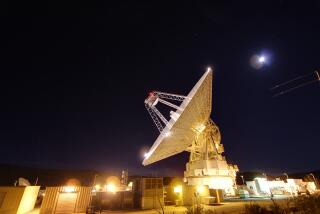Panel Faults NASA’s Mars Missions
WASHINGTON — The federal space agency’s three failed missions to Mars last year were doomed by severe underfunding and management breakdowns that led overworked engineers to make preventable errors, according to a scathing independent review released Tuesday.
Responding to the criticism, the National Aeronautics and Space Administration immediately announced that its quest to find traces of life on Mars will be reorganized. The agency said that it will create a reserve fund to cover unexpected program costs. It delayed for two years, until at least 2003, one of two scheduled Mars missions. And it named one official to oversee the entire effort to explore the Red Planet.
The report by an 18-member board of government, aerospace industry and academic experts tracked the findings of other outside investigations, released earlier this month. But it went into greater detail and carried more clout. It was commissioned by NASA Administrator Daniel S. Goldin.
Thomas Young, a retired aerospace engineer whose career included senior management jobs with NASA and Lockheed Martin, headed the panel. Its report said that the embarrassing technical failures have a common cultural denominator: an intense drive to meet budgets and timetables that pushed managers and engineers to take on escalating levels of risk.
Although it did not repudiate NASA’s new philosophy of “faster, better, cheaper” space missions, it added a critical corollary: “If not ready, do not launch.”
“Space missions are a ‘one strike and you are out’ activity,” the board’s report concluded. “Thousands of functions can be correctly performed, and one mistake can be mission catastrophic. Mistakes are prevented by oversight, test[ing] and independent analysis, which were deficient.”
NASA Acknowledges Its Mistakes
NASA embraced the panel’s findings as a guide for getting its troubled Mars program back on track.
“We found the boundary, and we are stepping back from that boundary,” Edward Weiler, NASA’s associate administrator for space science, said at a news conference at the agency’s headquarters. “We could have probably pulled these missions off if we were a little less cheap,” he ruefully acknowledged.
Edward Stone, director of the Jet Propulsion Laboratory in Pasadena, which managed the Mars missions, acknowledged that better “checks and balances” are needed. But Stone said that he had no inkling of a problem. “We had reviews throughout the program, and the reviews basically supported that we were meeting the challenge.”
A leading NASA critic reacted favorably to the report. “They clearly acknowledged these projects were underfunded and laid out a set of initiatives to avoid problems in the future,” said John Pike of the Federation of American Scientists.
But on Capitol Hill, Rep. Dana Rohrabacher (R-Huntington Beach), chairman of the space and aeronautics subcommittee of the House Science Committee, said he is not convinced that more money for NASA is the answer. “That’s the easy way out,” he said.
The report estimated that the failed Mars missions were underfunded by about 30%.
The outside panel identified for the first time a probable cause for December’s loss of the Mars Polar Lander. The spacecraft was designed to hunt for evidence of water on Mars. It also carried a microphone that could have transmitted the sound of Martian winds to listeners on Earth.
The failure was almost certainly caused by a software flaw believed to have shut down the spacecraft’s descent engines about 130 feet above its intended landing zone. That would have sent the lander crashing to its destruction at about 50 mph.
That problem has been corrected on a new Polar Lander, which may not fly until 2003 or later.
Also lost in the same mishap was Deep Space 2, carried aboard the lander, which consisted of two mini-probes designed to be fired on descent and to burrow into the Martian soil to detect possible traces of ice.
Panel Faults Launch of Deep Space 2
The panel was unable to find a probable cause for the loss of Deep Space 2, but it said that the probe should not have been launched in the first place because of insufficient testing.
The third failure last year occurred in September, when the Mars Climate Orbiter went hurtling into the planet’s atmosphere because of a navigational error. That mistake came about because Denver-based contractor Lockheed Martin Astronautics had programmed the spacecraft using English units rather than the metric units called for in specifications.
All three vehicles were designed to search for traces of water, which could point to the possibility of life on Mars and could also supply future human explorers of the planet.
Asked if the losses were caused by “stupid mistakes,” panel chairman Young responded: “These mistakes were in areas where we know how to do things and do them well.”
Young’s panel was evenhanded in apportioning blame among NASA headquarters, JPL and Lockheed Martin.
Lockheed Martin’s proposal was overly optimistic in estimating how cheaply the Mars probes could be developed, the report said. The panel said that the cost of designing and building the orbiter and lander was $188 million, slightly less than the 1997 Pathfinder mission that successfully landed a small vehicle mounted with a camera on Mars.
“This is striking, given the fact the . . . project was delivering both an orbiter and a lander as well as three times the amount of science [as Pathfinder],” the report said.
One result was that even though Lockheed Martin engineers ended up working 80 hours a week or longer, the board found there was insufficient testing of the software.
JPL’s Management Is Criticized
The report faulted JPL’s oversight of the contractor. “The JPL management perception was that no cost increase was permissible,” said the report. “The pressure of meeting the cost and schedule goals resulted in an environment of increasing risk in which too many corners were cut.”
It depicted NASA headquarters as remote and uninterested in anything but good news. “NASA headquarters was rigid in adhering to unrealistic concerns,” the report concluded.
As an example of cost-cutting on the Mars Polar Lander mission, the panel cited a design detail that prevented transmission of flight data during the landing, thus depriving scientists from determining the exact cause of the lander’s failure.
The software problem cited as the probable cause of the accident was discovered after the fact by Lockheed Martin engineers. If they had known about it beforehand, Young said, some relatively simple programming changes could have solved the problem.
The official who will oversee future Mars missions is Scott Hubbard, who now heads astrobiology and space programs at Ames Research Center at Moffett Field, Calif.
More to Read
Sign up for Essential California
The most important California stories and recommendations in your inbox every morning.
You may occasionally receive promotional content from the Los Angeles Times.










